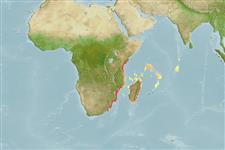Environment: milieu / climate zone / depth range / distribution range
Écologie
marin démersal; profondeur 35 - 75 m (Ref. 4313). Subtropical
Western Indian Ocean: Mozambique to Durban, Natal in South Africa. Reported as likely at Seychelles (Ref. 1623) but Randall and van Egmond 1994 (Ref. 10685) believe otherwise.
Taille / Poids / Âge
Maturity: Lm ? range ? - ? cm
Max length : 14.0 cm TL mâle / non sexé; (Ref. 4313)
Description synthétique
Clés d'identification | Morphologie | Morphométrie
Épines dorsales (Total) : 13 - 15; Rayons mous dorsaux (Total) : 8 - 10; Épines anales: 2; Rayons mous anaux: 8 - 10. Mostly brownish, mottled in brown, pink and yellow (Ref. 4313).
Life cycle and mating behavior
Maturities | Reproduction | Spawnings | Egg(s) | Fecundities | Larves
Eschmeyer, W.N., 1986. Scorpaenidae. p. 463-478. In M.M. Smith and P.C. Heemstra (eds.) Smiths' sea fishes. Springer-Verlag, Berlin. (Ref. 4313)
Statut dans la liste rouge de l'IUCN (Ref. 130435)
Menace pour l'homme
Harmless
Utilisations par l'homme
Outils
Articles particuliers
Télécharger en XML
Sources Internet
Estimates based on models
Preferred temperature (Ref.
123201): 21.8 - 26.2, mean 25.3 °C (based on 16 cells).
Phylogenetic diversity index (Ref.
82804): PD
50 = 0.5625 [Uniqueness, from 0.5 = low to 2.0 = high].
Bayesian length-weight: a=0.00389 (0.00180 - 0.00842), b=3.12 (2.94 - 3.30), in cm total length, based on all LWR estimates for this body shape (Ref.
93245).
Niveau trophique (Ref.
69278): 3.8 ±0.7 se; based on size and trophs of closest relatives
Résilience (Ref.
120179): Haut, temps minimum de doublement de population inférieur à 15 mois (Preliminary K or Fecundity.).
Fishing Vulnerability (Ref.
59153): Low vulnerability (10 of 100).
